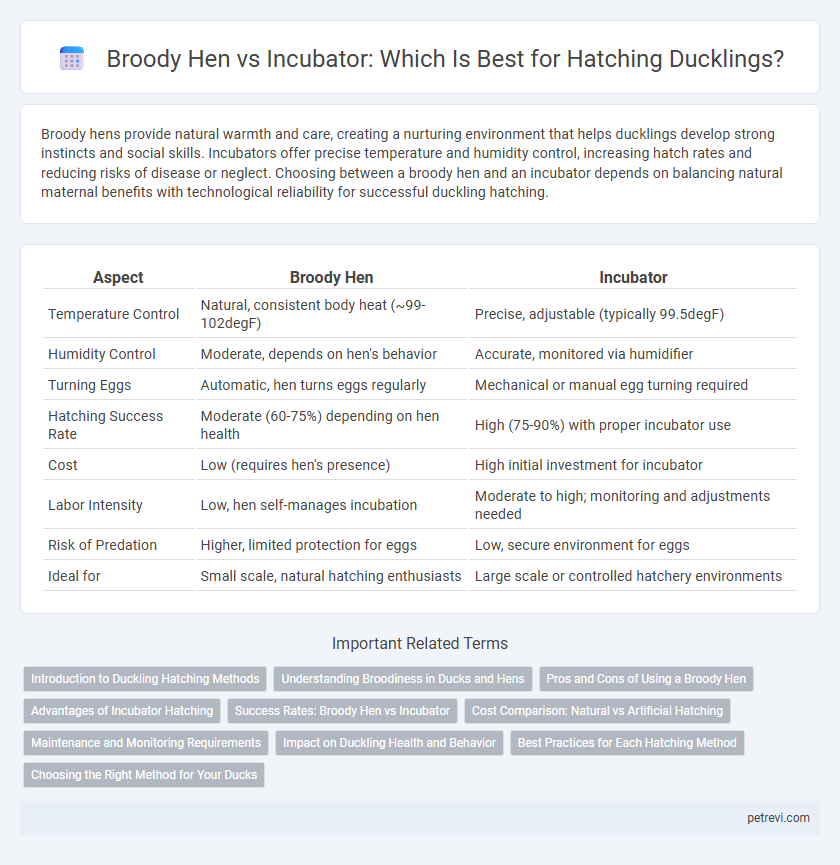Broody hens provide natural warmth and care, creating a nurturing environment that helps ducklings develop strong instincts and social skills. Incubators offer precise temperature and humidity control, increasing hatch rates and reducing risks of disease or neglect. Choosing between a broody hen and an incubator depends on balancing natural maternal benefits with technological reliability for successful duckling hatching.
Table of Comparison
| Aspect | Broody Hen | Incubator |
|---|---|---|
| Temperature Control | Natural, consistent body heat (~99-102degF) | Precise, adjustable (typically 99.5degF) |
| Humidity Control | Moderate, depends on hen's behavior | Accurate, monitored via humidifier |
| Turning Eggs | Automatic, hen turns eggs regularly | Mechanical or manual egg turning required |
| Hatching Success Rate | Moderate (60-75%) depending on hen health | High (75-90%) with proper incubator use |
| Cost | Low (requires hen's presence) | High initial investment for incubator |
| Labor Intensity | Low, hen self-manages incubation | Moderate to high; monitoring and adjustments needed |
| Risk of Predation | Higher, limited protection for eggs | Low, secure environment for eggs |
| Ideal for | Small scale, natural hatching enthusiasts | Large scale or controlled hatchery environments |
Introduction to Duckling Hatching Methods
Broody hens use natural warmth and instinct to incubate duck eggs, providing a humid and gentle environment crucial for successful hatching. Incubators offer precise temperature and humidity control, ensuring consistent conditions that can improve hatch rates and allow large-scale hatching of ducklings. Understanding the pros and cons of natural brooding versus artificial incubation helps optimize duckling survival and development.
Understanding Broodiness in Ducks and Hens
Broody hens naturally incubate eggs by maintaining consistent warmth and humidity, crucial for successful duckling development. Ducks exhibit less frequent broodiness, often requiring external incubators to replicate optimal incubation temperature around 99.5degF and humidity near 55-60%. Understanding broodiness in both species helps determine whether natural incubation by hens or controlled incubators yield higher hatch rates for ducklings.
Pros and Cons of Using a Broody Hen
Using a broody hen for duckling hatching offers natural warmth and constant care, ensuring ducklings receive essential nurturing and protection against predators. However, broody hens may be less reliable in maintaining consistent temperature compared to incubators, potentially leading to uneven embryo development or lower hatch rates. The broody hen's tendency to leave the nest intermittently also increases risks of egg chilling and decreased hatch success.
Advantages of Incubator Hatching
Incubator hatching offers precise temperature and humidity control, ensuring a higher hatch rate compared to broody hens. It eliminates the risk of predator attacks and inconsistent care, providing a stable environment essential for sensitive duckling embryos. Automated turning features in incubators further enhance embryo development, reducing labor and improving hatch success.
Success Rates: Broody Hen vs Incubator
Broody hens typically provide natural warmth, humidity, and protection, leading to duckling hatching success rates of around 70% to 90%, depending on the hen's experience and environmental conditions. Incubators offer precise temperature and humidity control, often achieving consistent success rates between 75% and 95%, especially when using calibrated equipment and proper ventilation. Success rates in both methods can vary significantly based on factors such as egg fertility, handling, and maintenance, with incubators favored for scalability and broody hens for natural behavior benefits.
Cost Comparison: Natural vs Artificial Hatching
Broody hens provide a cost-effective, natural incubation method for ducklings, requiring minimal investment beyond feed and care, whereas incubators involve upfront costs for equipment, electricity, and maintenance. Natural hatching benefits from the hen's built-in temperature regulation and humidity control, reducing utility expenses commonly associated with artificial incubation. Over time, the natural approach proves more economical for small flocks, while incubators offer scalability despite higher operational costs.
Maintenance and Monitoring Requirements
Broody hens require minimal maintenance as they naturally regulate temperature and turn the eggs, but constant monitoring is essential to ensure they remain healthy and undisturbed. Incubators demand regular maintenance, including precise temperature and humidity control, frequent egg turning, and sanitation to prevent bacterial growth. Monitoring in incubators must be diligent and systematic to optimize hatch rates and ensure duckling viability.
Impact on Duckling Health and Behavior
A broody hen naturally regulates temperature and humidity, promoting stronger immune systems and healthier ducklings through consistent maternal care and warmth. Incubators provide precise environmental control but lack the natural behavioral stimuli from a hen, sometimes resulting in weaker social bonding and increased stress for hatchlings. Studies indicate ducklings hatched under broody hens exhibit more robust health and natural behaviors compared to artificially incubated counterparts.
Best Practices for Each Hatching Method
Broody hens provide natural warmth, humidity, and turning of eggs, creating ideal conditions for duckling development, but require close monitoring to ensure consistent temperature around 99.5degF and humidity at 55-65%. Incubators offer controlled environments with precise temperature and humidity settings, automated egg turning, and protection from predators or environmental fluctuations, with recommended settings typically around 99.5degF and 55-65% humidity depending on the incubation stage. Best practices include regularly checking eggs for fertility, maintaining proper ventilation, and adjusting humidity levels to prevent dehydration or mold, maximizing hatch rates for both natural brooding and artificial incubation methods.
Choosing the Right Method for Your Ducks
Choosing the right hatching method for ducklings depends on your goals, available space, and attention capacity. A broody hen provides natural warmth, humidity, and protection, promoting stronger immune systems and natural imprinting, while an incubator offers precise temperature and humidity control, enabling larger-scale hatching and consistency. For backyard keepers with fewer eggs, a broody hen often ensures better survival rates, whereas incubators suit commercial or large-scale hatching with increased monitoring and maintenance.
Broody Hen vs Incubator for Duckling hatching Infographic

 petrevi.com
petrevi.com